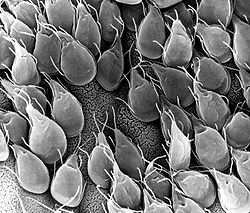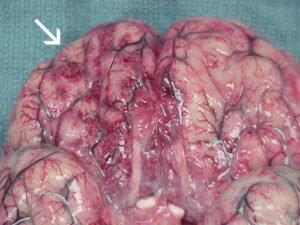We are getting more and more questions these days about these four nasties in drinking water. Each of them are seriously nasty in their own way, ranging from extreme diarrhea to brain eating amoeba, so it’s good to be able to plan around the possibility of finding it in your water.
We don’t want to panic you, and we must stress that if you are drinking municipal chlorinated water you are way ahead of people in the country.
 Blastocystis
Blastocystis
One of the most common human parasites in the world, It has a global distribution.
It’s the most common parasitic infection in the USA, where it infected approximately one person in four of the total population during year 2000.Less developed areas had 100% infection rates.
High rates of infection are found in individuals in developed countries who work with animals.
Although the role of Blastocystis hominis in human disease is controversial, a systematic survey of research studies conducted by 11 infectious disease specialists from nine countries, found that over 95% of papers published in the last 10 years identified it as causing illness in healthy individuals.
We estimate that at least 1 billion people worldwide are cothout knowing and without feeling sick. Blastocystis may colonise the intestine for a long time (i.e. months or years).
So.. as you can see, Blasto is not really just a waterborne parasite.
How Blastocystis is transmitted is not known for certain, although the number of people infected seems to increase in areas where sanitation and personal hygiene is not adequate. Studies have suggested that risk of infection may increase through:
- ingesting contaminated food or water,
- exposure to a day care environment, or
- exposure to animals.
How can I prevent infection with Blastocystis?
- Wash your hands with soap and warm water after using the toilet, changing diapers, and before handling food.
- Teach children the importance of washing hands to prevent infection.
- Avoid water or food that may be contaminated.
- Wash and peel all raw vegetables and fruits before eating.
- When traveling in countries where the water supply may be unsafe, avoid drinking unboiled tap water and avoid uncooked foods washed with unboiled tap water.
Giardia Lambda

Giardia lives inside the intestines of infected humans or other animals.
Infection is through ingesting or coming into contact with contaminated food, soil, or water. The Giardia parasite originates from contaminated items and surfaces that have been tainted by the feces of an infected carrier. So when I spent time exploring the feed creeks of our local water supply and discovered two young women excreting in the creek, I had good reason to conclude that our reservoir has Giardia.
Symptoms of Giardia may begin 2 days after infection, include violent diarrhea, excess gas, stomach or abdominal cramps, upset stomach, and nausea. Resulting dehydration and nutritional loss may need immediate treatment. Typical infection within an individual can be slight, resolve without treatment, and last between 2–6 weeks, although it can sometimes last longer and/or be more severe. Coexistence with the parasite is possible (symptoms fade), but you can remain a carrier and transmit it to others.
Giardia causes a disease called Giardiasis, which causes the villi of the small intestine to atrophy and flatten, resulting in malabsorption in the intestine. Lactose intolerance can persist after the eradication of Giardia from the digestive tract.
Person-to-person transmission accounts for the majority of Giardia infections and is usually associated with poor hygiene and sanitation. Giardia is found on the surface of the ground, in the soil, in undercooked foods, and water along with improper cleaning of fecal material from the hands after handling infected feces. Water-borne transmission is associated with the ingestion of contaminated water. In the U.S., outbreaks typically occur in small water systems using inadequately treated surface water. Venereal transmission happens through fecal-oral contamination. Additionally, diaper changing and inadequate hand washing are risk factors for transmission from infected children. Lastly, food-borne epidemics of Giardia have developed through the contamination of food by infected food-handlers.
The CDC recommends hand-washing and avoiding potentially contaminated food and untreated water.
How can I remove Giardia from my drinking water?
To kill or inactivate Giardia, bring your water to a rolling boil for one minute (at elevations above 6,500 feet, boil for three minutes) Water should then be allowed to cool, stored in a clean sanitized container with a tight cover, and refrigerated.
An alternative to boiling water is using a point-of-use filter. Not all home water filters remove Giardia. Filters that are designed to remove the parasite should have one of the following labels:
- Reverse osmosis,
- Absolute pore size of 1 micron or smaller.
 Cryptosporidium
Cryptosporidium
Cryptosporidium is a microscopic parasite that causes the diarrheal disease cryptosporidiosis. Both the parasite and the disease are commonly known as “Crypto.”
There are many species of Cryptosporidium that infect animals, some of which also infect humans. The parasite is protected by an outer shell that allows it to survive outside the body for long periods of time and makes it very tolerant to chlorine disinfection.
While this parasite can be spread in several different ways, water (drinking water and recreational water) is the most common way to spread the parasite. Cryptosporidium is a leading cause of waterborne disease among humans in the United States and Australia.
Many but not all home water filters remove Cryptosporidium. Some filter designs are more suitable for removal of Cryptosporidium than others. Reverse osmosis filters do protect against Cryptosporidium. Some other types of filters that function by micro-straining also work. Look for a filter that has a pore size of 1 micron or less. This will remove microbes 1 micron or greater in diameter (Cryptosporidium, Giardia).
 Naegleria Fowleri
Naegleria Fowleri
This little nasty gained press this year when a baby Australian died of it.
Naegleria fowleri (commonly referred to as the “brain-eating amoeba” or “brain-eating ameba”), is a free-living microscopic ameba*, (single-celled living organism). It can cause a rare and devastating infection of the brain called primary amebic meningoencephalitis (PAM). The ameba is commonly found in warm freshwater (e.g. lakes, rivers, and hot springs) and soil. Naegleria fowleri usually infects people when contaminated water enters the body through the nose. Once the ameba enters the nose, it travels to the brain where it causes PAM, which is usually fatal. Infection typically occurs when people go swimming or diving in warm freshwater places, like lakes and rivers.
The largest amount of experience in managing Naegleria fowleri-contaminated water supplies is in Australia, which had multiple deaths in four states during the 1970s and 1980s that were linked to swimming or having other nasal exposure to contaminated drinking water. The infections were linked to piping drinking water overland, sometimes for hundreds of kilometers, that resulted in the water being heated and having low disinfectant levels. These conditions allowed the water and pipes to become colonized by Naegleria fowleri. Several water systems in the states of Western Australia and South Australia continue to monitor regularly for Naegleria fowleri colonization in drinking water distribution systems . Experience gained in managing Naegleria fowleri contamination of specific water systems has prevented further infections in Australia since that time.
You cannot get infected from swallowing water contaminated with Naegleria.

You did not say how to remove Blastocystis from a water supply, is it possible?
Sam, give Leon a call or an email. We have an excellent technology to remove it!
Sam, it is indeed possible. Email us and we will assist.
Yes, Sam. Give us a call
Ian, The problem I have in Monroe, La is there are water companies that dont comply with Regulations and since these places have Parishes, instead of Counties, Things DONT get looked into and the common thing the Old people who are in these Positions who need to be removed is that Chlorine and UNQUALIFIED individuals are doing this. How can a water company WITHOUT informing Residents switched our water from Monroe City, to Well Water. You cant do this without proper filters, yet I have a letter that there is Fecal material and a Brain Eating Amoeba in Our drinking water. There was suppose to be a 60 day strong Chlorine Burn, but that was stopped by this Doctor from the Dept of Health and Hospitals. Who are these people.. I want to know how to protect myself and the woman Im helping. I need to know what kind of faucet mounted drinking filter that will remove it. I told the water company that it smelled like raw sewage, greenish and had some bubbles that stayed on the surface. My dog wont drink it. I will NOT keep buying bottled water. I want to know what is a damn good filter, within reason of price. Thank you
Wow, Thomas! That’s American water!
Will a
.1 micron filter
remove blastocystis?
No, Ramis